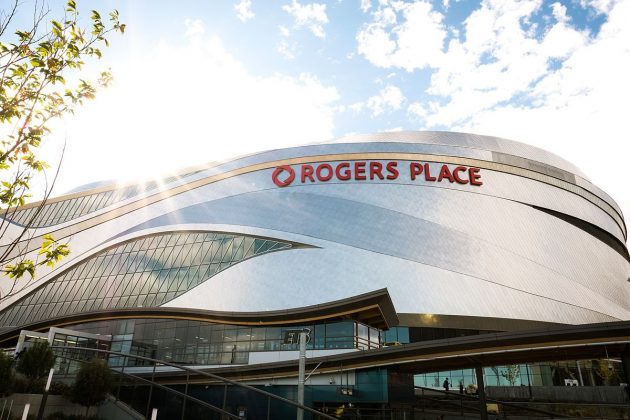
Offside: The secret deals involving public money for sports stadiums
by Ryan Gauthier, Thompson Rivers University

Economists are almost unanimous in finding that cities receive little economic benefit from stadiums

Rogers Place Arena in Edmonton. PHOTO: Alexscuccato, via Wikimedia Commons
The new hockey season is almost here. As training camps open and players return to the ice, another great sports tradition is back in full swing: the debate over whether professional teams should receive public funds to build new arenas and stadiums.
The Calgary Flames and the Ottawa Senators are the latest teams working on this power play.
The Flames want to replace the 35-year-old Saddledome. Billionaire Murray Edwards, one of the wealthiest Canadians and the owner of the Flames, is looking for public money for his team’s new home.
The Senators want to move out of the Ottawa suburb of Kanata into a new downtown location. Billionaire Eugene Melnyk, the owner of the Senators, is not looking for public money for his new arena but is still negotiating terms to build on federally owned land near the Canadian War Museum.
Both of these negotiations are taking place under the shadow of Edmonton’s new arena. Opened in 2016, Rogers Place cost $483.5 million to build. The Edmonton Oilers paid $132.5 million, the City of Edmonton kicked in $226 million through a combination of city funds and a new local property tax, and fans will hand over $125 million through a ticket tax. Edmonton’s arena has set a precedent in Canada.
Poor investments for cities
Using public money has been a feature of sports in the United States since the 1950s, even though economists are almost unanimous in finding that cities receive little economic benefit from stadiums.
New jobs created by a stadium are part-time and low-wage, such as ushers or concession workers. Without a new stadium, construction workers would simply build other things. Local businesses might benefit a bit from a new stadium, but it’s unclear. If cities are building stadiums to stimulate the economy, they would be better off having the mayor throw money out of a helicopter.
But the gravy train won’t stop. Between 2005 and 2017, 39 stadiums in North America were approved to be built with public subsidies. It seems that nothing will stop politicians from handing over public dollars to professional sports teams. The state of Michigan granted permission for Detroit to sell $450 million in bonds to finance a new hockey arena only six days after Detroit claimed bankruptcy.
Undemocratic deals
Compounding the poor economic outcomes is the undemocratic nature of many stadium deals. Politicians are unlikely to risk the public vote on stadium funding. Instead, city councils vote on the deals that they negotiate with the teams.
These negotiations are increasingly being done behind closed doors.
A deal to build a new stadium for the Atlanta Braves in Cobb Country, Ga., wasn’t revealed to the public until after the fact. Team president John Schurerholz was unapologetic for the secrecy.
“If it had leaked out, this deal would not have gotten done…people would have started taking the position of ‘We don’t want that to happen. We want to see how viable this was going to be,’ ” said Schurerholz.
When the Cobb County Board of Commissioners finally held a public hearing before approving over $300 million in subsidies, only 12 people were allowed to speak. Others who requested time to speak were “escorted from the room.”
The removal of transparency and public participation is not just an American problem. The Calgary Flames recently said they would only resume negotiations for a new arena if the media and public are not informed until an agreement is reached.
Without public involvement, team owners only need to cozy up to city council, rather than make their pitch to hundreds of thousands of citizens. This situation increases the risk that a deal will not consider the benefit to the public, and also runs the risk of outright corruption.
What happens after the stadium is built, and promises about jobs and economic benefits aren’t kept by the team? Probably nothing. In Edmonton, promises to hire people from low-income neighbourhoods around the arena were only partially kept.
In Winnipeg, the province of Manitoba recently wrote off $118 million owed on Investors Group Field, a new football stadium that opened in 2013. The former politicians involved in making that deal have been silent. That’s not unusual: once a team begins playing in a new stadium, it seems only the on-field performance matters anymore.
The lack of democracy, transparency and accountability matters for stadiums — and also for hosting major sporting events.
As Calgary works on a bid to host the 2026 Winter Olympics, and Canada prepares to co-host the 2026 FIFA World Cup, more calls for building sporting infrastructure with public money will come.
While new stadiums and sport infrastructure can have some benefits — the 2010 Winter Olympics were considered a success — the risk of a fiasco like Montréal’s billion-dollar deficit and a new “Big Owe” is always lurking.
What can citizens do? They can demand that politicians and builders of stadiums be held accountable for the stadiums they build. They can demand that promises of community benefits are made concrete — and in writing. Construction and operation of a stadium should be overseen by an independent watchdog. Finally, there should be consequences for those who do not live up to their promises and who engage in corruption or other financial malfeasance.
As the old saying goes, you get rich by spending other people’s money. This won’t stop team owners and politicians from spending money on stadiums. But we can at least demand that these stadiums benefit the public whose money is being spent.
This article is republished from The Conversation. Read the article.
![]()